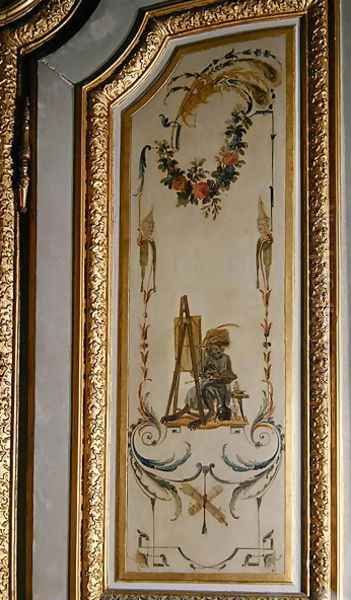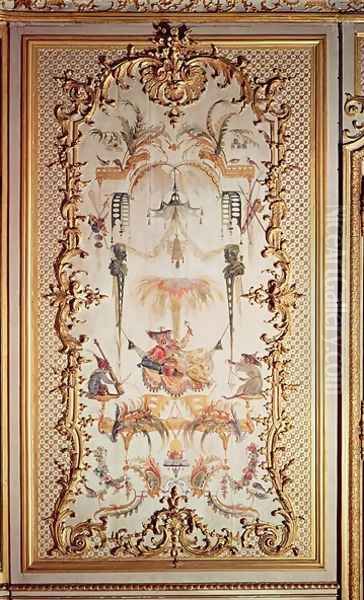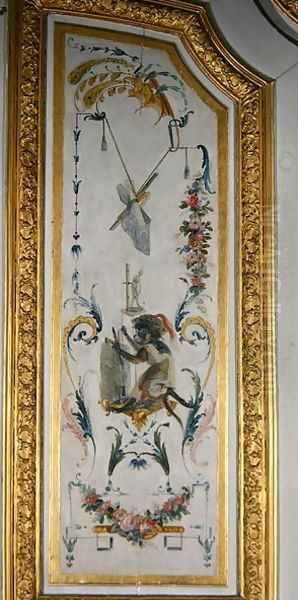Christophe Huet stands as a significant, albeit sometimes overlooked, figure in the vibrant artistic landscape of eighteenth-century France. Active primarily during the height of the Rococo period, Huet carved a unique niche for himself as a masterful animal painter and an exquisite decorative artist. His legacy is most famously tied to the whimsical and satirical genre of singerie, or "monkey trick," where primates mimic human activities, but his talents extended far beyond this charming specialty. Working alongside and sometimes in the shadow of more dominant figures, Huet contributed significantly to the decorative schemes of aristocratic residences, leaving behind works that encapsulate the elegance, wit, and exoticism of his era.
Early Life and Artistic Formation
Christophe Huet was born in France, likely around the year 1700, although some earlier sources suggest a birth year of 1694. He hailed from a family with established artistic roots. His father may have been Nicolas Huet the Elder, an artist active in the late seventeenth and early eighteenth centuries. Importantly, Christophe was the uncle, not the son or brother, of the later, perhaps more widely known animal painter Jean-Baptiste Huet (1745-1811), ensuring the Huet name resonated across different generations of French art. This familial connection to the arts undoubtedly provided an environment conducive to his own development.
Details regarding Huet's formal training remain somewhat speculative, a common challenge when reconstructing the lives of artists outside the absolute highest echelons of the Royal Academy of Painting and Sculpture. However, his style and thematic choices suggest connections to several key figures. He was demonstrably influenced by, and later collaborated with, the preeminent animal and still-life painter Jean-Baptiste Oudry (1686-1755). Oudry's meticulous rendering of animal textures and his dynamic compositions certainly left a mark on Huet.

Some art historians propose that Huet might also have spent time in the studio of Alexandre-François Desportes (1661-1743), another giant of French animal painting, known for his lively depictions of hunts and royal menageries. Furthermore, the influence of Claude Gillot (1673-1722), a master of theatrical scenes and arabesque designs, often featuring commedia dell'arte figures and monkeys, seems apparent in Huet's penchant for singerie and decorative fantasy. Gillot, notably, was also the master of Antoine Watteau. It's also been suggested that Huet may have had connections to the workshop of Charles Audran, part of another significant family of engravers and decorative artists.
Regardless of his precise tutelage, Huet developed a distinct artistic personality. He became a member of the Académie de Saint-Luc in Paris, a guild that offered an alternative, though less prestigious, path to recognition than the Royal Academy. Within the Académie de Saint-Luc, he achieved the status of a professor, indicating respect among his peers for his skill and knowledge, particularly in the realm of animal painting and decoration.
The Art of the Singerie
Christophe Huet's name is inextricably linked with the singerie. This genre, depicting monkeys dressed in human clothes and engaging in human activities, enjoyed considerable popularity during the Rococo period. It tapped into a fascination with the exotic, a playful sense of satire directed at human follies and aristocratic pastimes, and the decorative potential of these agile, expressive creatures. While not the inventor of the genre – antecedents can be found in Flemish art and earlier French decoration, notably through artists like Claude Gillot – Huet became its most celebrated practitioner in eighteenth-century France.
Huet's singeries are characterized by their charm, wit, and technical finesse. He moved beyond simple caricature, imbuing his simian subjects with a surprising degree of personality and observational accuracy, even amidst their fantastical scenarios. His monkeys hunt, fish, skate, play musical instruments, conduct scientific experiments, paint portraits, and engage in elaborate social rituals, often mirroring the leisured pursuits of the aristocracy who commissioned these works.
These scenes were typically integrated into larger decorative schemes, often adorning wall panels (boiseries), overdoors, or folding screens. The lightheartedness and inherent absurdity of monkeys aping human behaviour perfectly suited the Rococo taste for amusement, elegance, and a gentle subversion of formality. Huet's compositions are typically airy and graceful, employing the characteristic curves and asymmetry of the Rococo style, often incorporating delicate floral motifs, arabesques, and elements of Chinoiserie.

Works like Singerie: The Fishermen exemplify his approach. Here, monkeys clad in contemporary attire engage in the leisurely activity of fishing, rendered with a blend of humour and surprising naturalism in the depiction of the animals themselves. The scenes provided amusement and a subtle commentary on the society of the time, viewed through the playful lens of animal mimicry.
Masterworks: The Chantilly Singeries
The undisputed pinnacle of Christophe Huet's achievement in the singerie genre, and indeed his most famous work overall, is the decoration of two small salons at the Château de Chantilly, executed around 1735-1737. Commissioned by Louis Henri, Duke of Bourbon and Prince of Condé (1692-1740), these rooms, known as the Grande Singerie (Large Monkey Room) and the Petite Singerie (Small Monkey Room), remain remarkably preserved and offer an immersive experience into Huet's world.
The Grande Singerie features large wall panels painted directly onto the wood (boiseries). Huet depicted monkeys engaged in activities reflecting the Duke's own interests and the life of the nobility: hunting with guns and hounds, sledding on ice, feasting, playing musical instruments, and even painting portraits. The scenes are framed by delicate Rococo borders and arabesques, creating a cohesive and enchanting environment. The monkeys are rendered with remarkable detail and animation, their costumes elaborate and their poses dynamic.
The adjacent Petite Singerie continues the theme but incorporates a stronger element of Chinoiserie, reflecting the period's intense fascination with East Asia. Here, monkeys interact with figures in imagined Chinese attire, set against landscapes featuring pagodas and exotic flora. This blending of singerie and Chinoiserie was a hallmark of Huet's decorative work, creating a doubly fantastical and fashionable environment. The colours are light and airy, dominated by whites, golds, and pastel shades, typical of the Rococo interior.
The Chantilly singeries are exceptional not only for their artistic quality and charm but also for their state of preservation and their status as a complete decorative ensemble conceived and executed by a single artist specializing in this unique genre. They cemented Huet's reputation and remain the primary reference point for his work, showcasing his mastery of composition, his keen observation of animal forms, and his ability to translate the playful spirit of the Rococo into captivating interior decoration.
Beyond Monkeys: Animal Painting and Observation

While the singeries are his most iconic creations, Christophe Huet was a highly capable animal painter in a more traditional sense. His skills extended to depicting a variety of fauna, often within landscape settings or as part of larger decorative compositions. He possessed a keen eye for animal anatomy and behaviour, capturing the characteristic postures and movements of different species.
His approach to animal painting differed somewhat from his illustrious contemporaries, Jean-Baptiste Oudry and Alexandre-François Desportes. While Oudry often focused on dramatic hunting scenes or meticulously rendered studies of exotic animals from the royal menagerie, and Desportes excelled at capturing the energy of the hunt and the textures of fur and feather, Huet's animal depictions often retained a decorative sensibility. Even when not anthropomorphized, his animals frequently inhabit idealized landscapes or serve as elements within balanced, ornamental compositions.
Works such as Wild Ducks Taking Flight, now housed in the Louvre Museum, demonstrate his ability to capture the dynamism of wildlife. The painting shows a group of ducks suddenly taking off from a marshy landscape, their wings caught in various stages of motion. Huet effectively conveys the energy and surprise of the moment, combined with a careful rendering of the birds and their watery habitat.
He often collaborated with Oudry on larger projects, such as the decorations for the Château d'Anet. In these instances, it's believed Huet may have contributed specific animal elements or decorative panels, working alongside the more established master. This collaboration highlights his recognized skill in animal depiction, even if Oudry generally received the greater acclaim for monumental works. Huet's strength lay perhaps less in dramatic naturalism and more in integrating animal life gracefully into the broader aesthetic framework of Rococo interiors.
A Master Decorator
Christophe Huet's identity as an artist is inseparable from his role as a decorator. In the eighteenth century, the distinction between "fine art" painting and "decorative" painting was less rigid than it later became. Artists frequently worked across different formats, contributing to the total aesthetic environment of aristocratic and bourgeois homes. Huet excelled in this domain, applying his skills to create harmonious and fashionable interiors.
His work extended beyond painted wall panels. He likely provided designs for other decorative elements, contributing to the cohesive look of Rococo interiors. The themes he explored in his paintings, particularly singeries and Chinoiserie, were readily adapted to other media, such as tapestries, ceramics, and potentially even furniture ornamentation, although direct attribution for designs in these areas can be difficult. His painted panels, however, were central to his decorative practice.
His collaboration on the Château d'Anet, particularly the "Golden Salon" or "Salon Doré," involved working alongside Jean-Baptiste Oudry. While Oudry might have handled the larger figurative or landscape elements, Huet's contribution likely focused on the intricate decorative borders, arabesques, and potentially specific animal motifs that frame the main compositions, showcasing his specialization within a larger team effort.
Huet's decorative style aligned perfectly with the Rococo ethos promoted by leading designers like Juste-Aurèle Meissonnier (1695-1750), known for his highly imaginative and asymmetrical designs, and fellow painters like François Boucher (1703-1770), who frequently incorporated pastoral scenes, mythological subjects, and Chinoiserie into decorative panels. Huet's work, with its emphasis on lightness, elegance, playful themes, and exotic touches, contributed to the overall vocabulary of Rococo decoration. He worked alongside other decorative painters like Claude III Audran (1658-1734), who was known for his arabesque designs and work at Versailles and other royal residences, representing a generation that bridged the late Baroque and early Rococo.
Chinoiserie and Exoticism
The eighteenth century witnessed a fervent European fascination with the arts and cultures of East Asia, particularly China. This taste, known as Chinoiserie, permeated fashion, decorative arts, garden design, and painting. Artists like Antoine Watteau (1684-1721) incorporated subtle exotic elements, while François Boucher created elaborate Chinoiserie scenes. Jean Pillement (1728-1808) later became one of its most dedicated practitioners, known for his delicate and imaginative Chinoiserie designs.
Christophe Huet skillfully integrated Chinoiserie motifs into his work, often blending them seamlessly with his singeries. As seen in the Petite Singerie at Chantilly, his compositions could feature figures in imagined Chinese dress, fantastical pagodas, exotic birds and flowers, and delicate lattice patterns, all rendered with the light touch and asymmetrical grace characteristic of the Rococo.
This fusion of the singerie and Chinoiserie created a doubly exotic and playful effect. Monkeys, already seen as exotic creatures, were placed within an imagined Far Eastern setting, enhancing the sense of fantasy and escapism. This combination proved highly fashionable, appealing to aristocratic patrons seeking novel and amusing decorations for their intimate salons and cabinets. Huet's ability to synthesize these popular trends while maintaining his distinctive style contributed significantly to his success as a decorative artist. His Chinoiserie elements, like his singeries, were less about ethnographic accuracy and more about evoking a mood of refined fantasy and distant charm.
Style and Technique
Christophe Huet's artistic style is firmly rooted in the French Rococo. His works prioritize elegance, lightness, and decorative harmony over grandiosity or dramatic intensity. He favoured curving lines, asymmetrical compositions, and a generally light colour palette, although his works at Chantilly demonstrate a rich use of colour within the overall scheme.
His technique involved careful observation, particularly of animals, combined with a fluid and graceful brushwork suitable for decorative surfaces. For his most famous works, like the Chantilly panels, he painted directly onto carved wooden boiseries, integrating his art into the architectural framework of the room. He also worked on canvas for easel paintings or potentially for insertion into paneling.
His rendering of animals, especially monkeys, combines anatomical understanding with expressive characterization. While adhering to the decorative conventions of the time, there is a liveliness and individuality to his creatures that elevates them beyond mere ornamental motifs. The integration of figures, animals, architectural elements, and landscape backgrounds is typically seamless, creating unified and visually engaging compositions.
Compared to the more robust or naturalistic styles of Oudry or Desportes, Huet's touch is generally lighter and more whimsical. His work shares affinities with the fêtes galantes of Watteau or Nicolas Lancret (1690-1743) in its depiction of leisurely pursuits and its overall mood of refined amusement, albeit translated into the unique idiom of animal painting and singerie. His decorative sensibility also connects him to the tradition of French ornamental design, perhaps influenced by earlier figures like Charles de La Fosse (1636-1716) who played a key role in the transition towards lighter, more colourful decorative painting.
Collaborations and Contemporaries
The art world of eighteenth-century Paris was a relatively interconnected milieu, and Christophe Huet interacted with several prominent contemporaries. His most documented collaboration was with Jean-Baptiste Oudry, particularly at the Château d'Anet. This suggests a working relationship where their respective skills – Oudry's mastery of large-scale compositions and animal realism, Huet's finesse in decorative detail and specialized themes like singerie – could complement each other.
His work inevitably invites comparison with Alexandre-François Desportes, the other leading animal painter of the era. While both depicted animals with great skill, their focus and style differed, with Desportes often closer to the tradition of the Flemish masters like Frans Snyders, emphasizing abundance and the vigour of the hunt.
Huet's engagement with singerie places him in a lineage that includes Claude Gillot, whose theatrical and ornamental work prefigured Rococo fantasy. The broader context of Rococo decoration connects him to figures like François Boucher, whose pastoral and mythological panels adorned many elite interiors, and Jean Pillement, the specialist in Chinoiserie. The overall aesthetic was shaped by designers like Juste-Aurèle Meissonnier, whose influence promoted the dynamic asymmetry and shell-like forms (rocaille) central to the style.
While perhaps not reaching the fame of Watteau, Boucher, or Jean-Honoré Fragonard (1732-1806), Huet occupied a significant position within this artistic ecosystem. He catered to a specific taste for witty, decorative, and exotic themes, finding patronage among discerning members of the aristocracy like the Prince of Condé. His contemporaries also included decorative painters like Charles-Joseph Natoire (1700-1777), who undertook large-scale decorative projects, showcasing the demand for artists skilled in adorning the elaborate interiors of the period.
Legacy and Rediscovery
During his lifetime, Christophe Huet enjoyed a solid reputation, particularly for his singeries and decorative work. His membership and professorship at the Académie de Saint-Luc attest to his standing among fellow artists. His commissions for prominent patrons like the Prince of Condé further indicate his success. However, following his death in 1759 and the subsequent shift in taste towards Neoclassicism, his work, like much Rococo art, fell somewhat out of favour and critical attention waned.
His rediscovery began in the late nineteenth century, coinciding with a renewed scholarly and collector interest in the art of the French eighteenth century. The art historian Louis Dimier played a crucial role, publishing an article on Huet in 1895 that highlighted his dual talents as both an animal painter and a decorator, particularly praising the Chantilly singeries. This helped to bring Huet's name back into art historical discourse. His inclusion in major biographical dictionaries of artists, such as the comprehensive Bénézit, further solidified his place, however specialized, in the annals of French art.
Today, Huet is recognized primarily for the Chantilly decorations, which are considered masterpieces of Rococo decorative painting and the definitive examples of the singerie genre. His other works appear periodically on the art market, and examples are held in museum collections, including the Louvre.
Modern Assessment and Conclusion
Modern scholarship assesses Christophe Huet as a highly skilled and imaginative artist who made a unique contribution to French Rococo art. While perhaps not an innovator on the scale of Watteau or Boucher, he excelled within his chosen specializations. His singeries are lauded for their wit, charm, and technical execution, offering a fascinating glimpse into the tastes and preoccupations of eighteenth-century elite society.
His role as a decorative artist is also acknowledged. He understood how to integrate painting into interior architecture, creating harmonious and engaging environments. His ability to blend singerie, Chinoiserie, and traditional animal painting within a cohesive Rococo framework demonstrates considerable artistic intelligence and adaptability.
Some critical discussion remains regarding his precise status – whether he should be viewed primarily as a master painter or a highly accomplished decorative artist. The serial nature of some decorative motifs and the collaborative context of many large projects complicate straightforward assessments based on notions of singular authorship or groundbreaking originality. However, this reflects the nature of artistic production in the period, where collaboration and adaptation were common.
Ultimately, Christophe Huet remains a captivating figure. His work embodies the playful elegance, fascination with the exotic, and decorative exuberance of the Rococo era. Through his masterful monkeys and refined decorative schemes, he left an indelible mark on the visual culture of eighteenth-century France, and his creations continue to delight and intrigue viewers today. The rooms at Chantilly stand as a testament to his unique talent, securing his legacy as the undisputed master of the Rococo singerie.